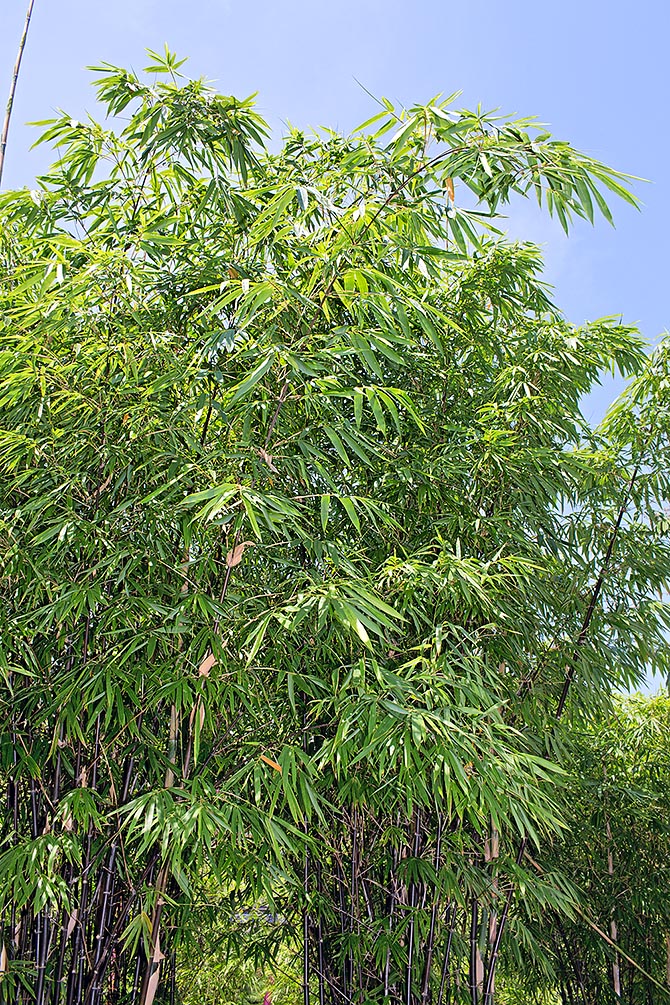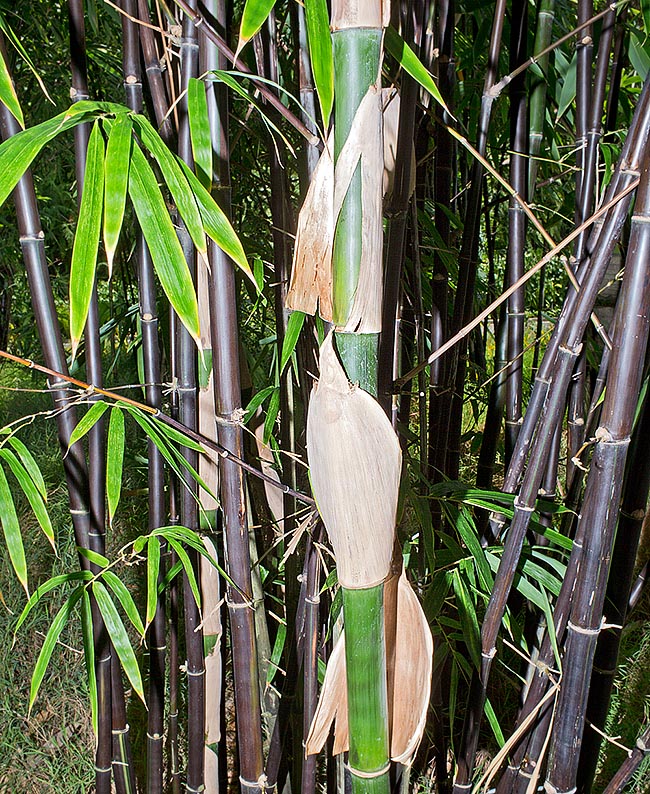Family : Poaceae

Text © Pietro Puccio

English translation by Mario Beltramini

Bambusa lako is native to Timor Leste in the Lesser Sunda Islands. Compact tufts with curved stems at the apex, that can be even 20 m tall. Noninvasive species of great landscape value for tropical gardens © Giuseppe Mazza
The species is native to Timor Leste in the Lesser Sunda Islands where it grows in the humid forests.
The name of the genus comes from the local Malay name “bambu”; the specific name is one of those used locally.
Common names: Timor black bamboo, Timor giant black (English); au lako, au meta, au metan, au lako meta (Timor Leste).
The Bambusa lako Widjaja (1997) is an evergreen rhizomatous perennial species forming rather compact tufts with stems (culms) erect, curved at the apex, that can reach the 20 m of height in the tropical zones, but that elsewhere keep lower, with a diameter of 4-10 cm.
The culms are hollow between the nodes, that are at 25-35 cm from each other, with 0,8-1,2 cm thick walls, with the surface particularly glossy initially of green colour that with the time turns blackish purple, possibly with thin green and yellow stripes.
When young the culms are protected by deciduous triangular bracts, 10-30 cm long, covered by blackish brown hairs.
The leaves, on short branches at the nodes, but in the lower part of the culms, are linear-lanceolate with long pointed apex and rough margins, pendulous, up to 25 cm long and 2,5-3 cm broad, of intense green colour, slightly pubescent in the lower part.
At the time of its description there were no blooming specimens and therefore in future its placing in the genus Bambusa might be reviewed, in fact molecular studies have revealed a high affinity with the Gigantochloa atroviolacea Widjaja (1987).
It reproduces by division of rhizomes and more frquently by stem cutting to be preferably done by the end of the vegetative season, when the plant has stored the maximum of reserves, utilizing a portion with two or three nodes provided of gems, taken from 2-3 years old culms, positioned obliquely or vertically on a sandy substratum rich of organic substance maintained humid at the temperature of 24-26 °C.

The young buds are edible, the growing culms protected by triangular deciduous bracts © Giuseppe Mazza
Cutivable in the tropical, subtropical climate regions and marginally temperate, where it can resist up to temperatures of -2/-3 °C, provided exceptional and for extremely short period, possibly with slight damage to the foliage.
It requires an exposition in full sun for a best growth, even if it stands a slight shade, and fertile soils, slightly acidic to slightly alkaline, well drained, maintained constantly humid. In the climates with a dry season it is to be regularly watered, even if adult individuals can overcome short drought periods, but at the expense of the general appearance, in such circumstances, in fact, the leaves wither and fall down; useful are regular fertilizations during the vegetative period with slow-releasing balanced products with microelements. It can be cultivated in capacious containers for the decoration of open spaces or of greenhouses and wintergardens where the climate does not allow its continuous permanence in open air.
The young buds are edible and the culms are utlized by the local populations in the constructions, for walls and coverings, and for realizing furniture and handicrafted items of various type, whilst the leaves are used as fodder.
→ To appreciate the biodiversity within the POACEAE family please click here.
